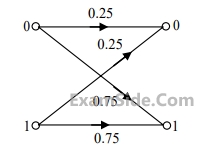1
GATE ECE 2017 Set 2
MCQ (Single Correct Answer)
+2
-0.6
Consider a binary memoryless channel characterized by the transition probability diagram shown in the figure.
 The channel is
The channel is
 The channel is
The channel is2
GATE ECE 2016 Set 2
Numerical
+2
-0
A binary communication system makes use of the symbols “zero” and “one”. There are channel errors. Consider the following events:
$${x_0}$$ : a " zero " is transmitted
$${x_1}$$ : a " one " is transmitted
$${y_0}$$ : a " zero " is received
$${y_1}$$ : a " one " is received
$${x_0}$$ : a " zero " is transmitted
$${x_1}$$ : a " one " is transmitted
$${y_0}$$ : a " zero " is received
$${y_1}$$ : a " one " is received
The following probabilities are given:
$$P({x_0}) = \,{3 \over 4},\,\left( {\,\left. {{y_0}} \right|{x_0}} \right) = \,{1 \over 2},\,\,and\,P\,\,\left( {\,\left. {{y_0}} \right|{x_1}} \right) = \,{1 \over 2}$$.
The information in bits that you obtain when you learn which symbol has been received (while you know that a " zero " has been transmitted) is _____________
Your input ____
3
GATE ECE 2016 Set 1
Numerical
+2
-0
Consider a discreet memoryless source with alphabet $$S = \left\{ {{s_0},\,{s_1},\,{s_2},\,{s_3},\,{s_{4......}}} \right\}$$ and respective probabilities of occurrence $$P = \left\{ {{1 \over 2},\,{1 \over 4},\,{1 \over 8},\,{1 \over {16}},\,{1 \over {32}},......} \right\}$$. The entropy of the source (in bits) is__________.
Your input ____
4
GATE ECE 2016 Set 3
Numerical
+2
-0
A voice-grade AWGN (additive white Gaussian noise) telephone channel has a bandwidth of 4.0 kHz and two-sided noise power spectral density $${\eta \over 2} = 2.5\, \times \,{10^{ - 5}}$$ Watt per Hz. If information at the rate of 52 kbps is to be transmitted over this channel with arbitrarily small bit error rate, then the minimum bit energy $${E_b}$$ (in mJ/bit) necessary is ________________
Your input ____
Questions Asked from Fundamentals of Information Theory (Marks 2)
Number in Brackets after Paper Indicates No. of Questions
GATE ECE 2025 (2)
GATE ECE 2023 (1)
GATE ECE 2022 (2)
GATE ECE 2017 Set 2 (1)
GATE ECE 2016 Set 2 (1)
GATE ECE 2016 Set 1 (1)
GATE ECE 2016 Set 3 (1)
GATE ECE 2014 Set 4 (1)
GATE ECE 2014 Set 2 (1)
GATE ECE 2014 Set 1 (1)
GATE ECE 2009 (1)
GATE ECE 2008 (1)
GATE ECE 2006 (1)
GATE ECE 2001 (1)
GATE ECE 1991 (1)
GATE ECE 1990 (1)
GATE ECE 1989 (1)
GATE ECE Subjects
Network Theory
Control Systems
Electronic Devices and VLSI
Analog Circuits
Digital Circuits
Microprocessors
Signals and Systems
Representation of Continuous Time Signal Fourier Series Fourier Transform Continuous Time Signal Laplace Transform Discrete Time Signal Fourier Series Fourier Transform Discrete Fourier Transform and Fast Fourier Transform Discrete Time Signal Z Transform Continuous Time Linear Invariant System Discrete Time Linear Time Invariant Systems Transmission of Signal Through Continuous Time LTI Systems Sampling Transmission of Signal Through Discrete Time Lti Systems Miscellaneous
Communications
Electromagnetics
General Aptitude